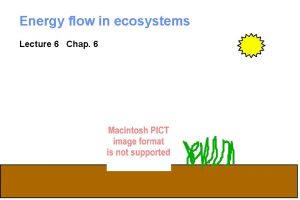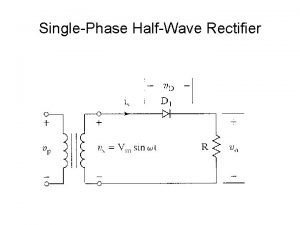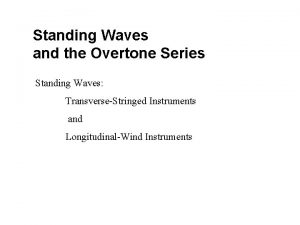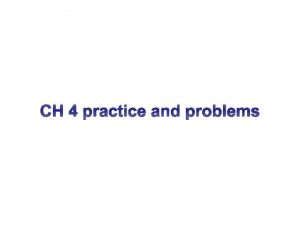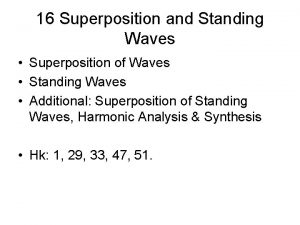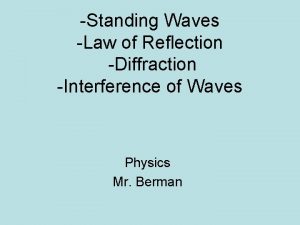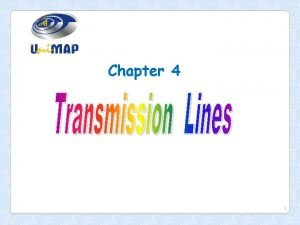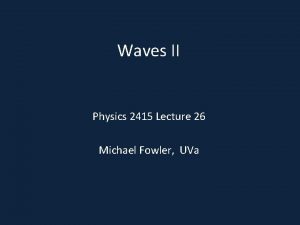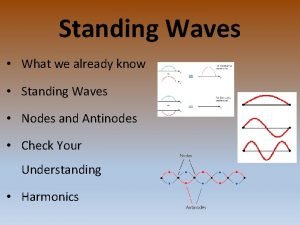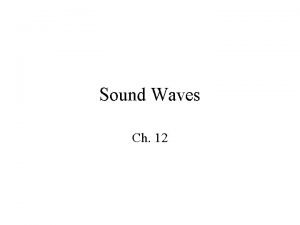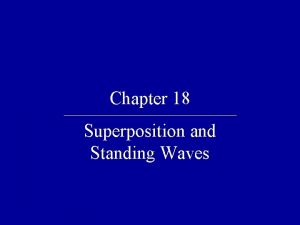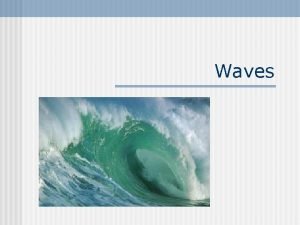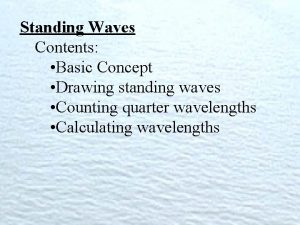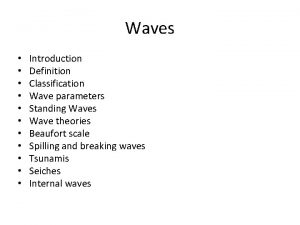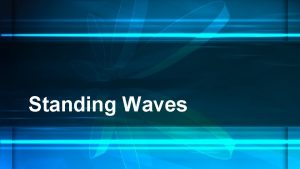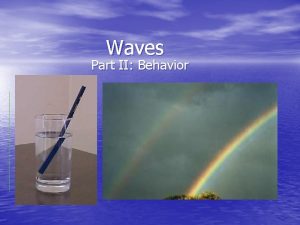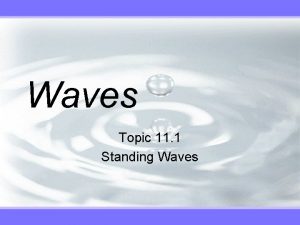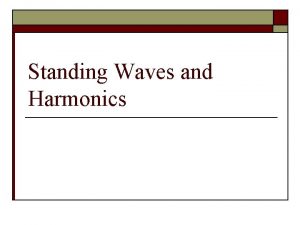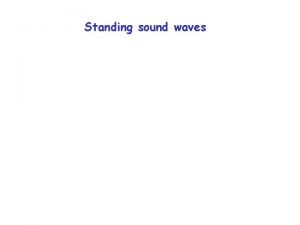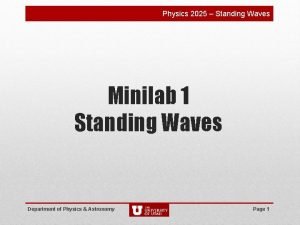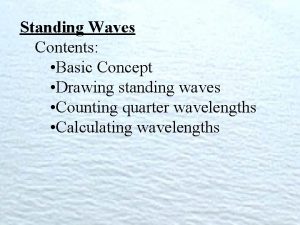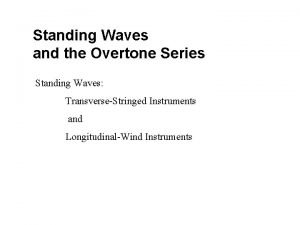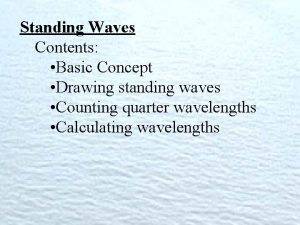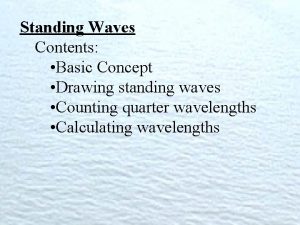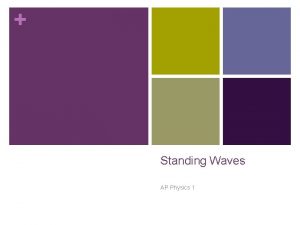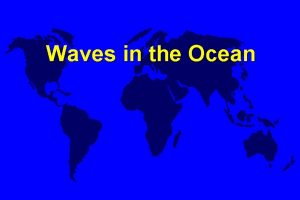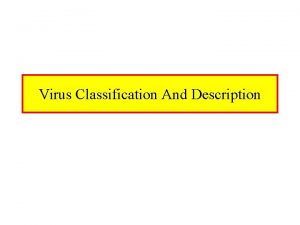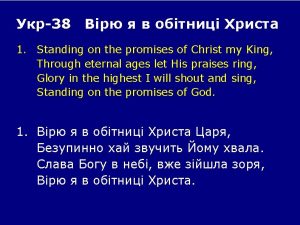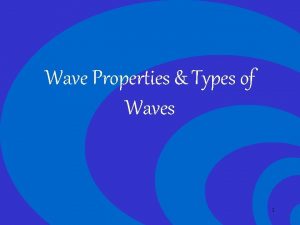Waves Introduction Definition Classification Wave parameters Standing Waves






























- Slides: 30

Waves • • • Introduction Definition Classification Wave parameters Standing Waves Wave theories Beaufort scale Spilling and breaking waves Tsunamis Seiches Internal waves

• Alternative rise and fall of a portion of water surface wind – Produced by Movement of objects in to or within the water Vibrations(earthquake of basin) – Transfer of energy into the water from wave inducing sources take place

Two basic type of waves Progressive waves Mores forward across water from the area it was formed Standing wave (seiches) Remain where they are produced and appear as a rocking back and forth of the water surface


• Size and type of wind-generated waves are controlled by: wind velocity, wing duration, fetch, and original state of sea surface. • As wind velocity increases wave length, period and height increase, but only if wind duration and fetch are sufficient. • Fully developed sea is when the waves generated by the wind are as large as they can be under current conditions of wind velocity and fetch. • Significant wave height is the average wave height of the highest 1/3 of the waves present and is a good indicator of potential for wave damage.

• Catastrophic waves – Are sudden violent and temporary waves – Caused by earthquakes, volcanic activity, landsholes in ocean – Types of catastrophic waves are tsunamis, landslide surges and storm surges • Shallow water wave- Waves in water shallower the ½ • Shear wave- oceans that vibrate particularsback & forth at right angles to direction of wave propagation

Surface waves Internal waves

Difference between surface and long waves Surface wave Internal wave a) Wind driven b) Also called capillary waves Occur on boundaries between water masses of different density with in ocean Rough, fast and unstable Internal waves are smoother slower, more stable and attain greater wave height Surface wave can be up to 20 m Internal waves can reach a height of height about 300 m or more Surface waves require more chargy Internal waves require less energy for generation

Characteristics of waves • Include crust at the top trough at bottom • Difference in elevation between crusts and trough is the wave height • Distance between crust or trough-wave length water steepness– The ratio of wave height to wave length • Capillarity is the initial restoring for any body of water • As wind blows – they create pressure and stress– and created capillary waves. • Capillary waves- 1. 74 cm wave length • As wind increased-Capillay wave developments increase-sea become rough • The capillarity force-become gravity wave and curve length increases-progressive wave

• Ocean and lakes are orbital progressive wave • The wave form moves forward with a steady velocity, so it is called “progressive”. • Wave period is the length of time it takes for a wave to pass a fixed point steepness is defined as the ratio of the wave • Waves with constant wavelength Waves touch bottom • When the wave builds and reaches a steepness greater than a ratio of 1: 7, the wave breakes and spills forward. • Breakers are normally assoicated with shorelines, where they are known as surf

• Waves in water deeper than half their wavelengths are known as deep water waves. • Their speed in meters per second can be approximated by the equation speed =g T/2∏, where T is the wave period and g is the acceleration due to gravity (9. 8 meters per second squared). • Shallow water waves are those movign in water less than one-twentieth the depth of their wavelength. • Shallow water waves include both seismic sea waves (tsunamis) generated by earthquakes at sea, and tide waves generated by the attraction of the Moon and the Sun on the ocean.

Standing waves • Also called stationary waves or seiches • Appears as a rocking back and forth of the water surface or an internal boundary with in water column • The line at which the seiche rocks is called node and it experiences no vertical motion. • Antinode is point where vertical motion is maximum • • Simple seiche: Has one node in centre and two antinodes at opposite edges. • Complex seiche: May have more nodes and antinodes. • Period of seiche: The time required for the water surface to rock back and forth once and is dependent upon the length and depth of the basin.

• Seiche period (Closed basin) T = 2 l gd Open ended basin T = 4 l gd • L= length of basin • D=water depth • G=gso cm/tec 2 • Standing waves are trigerred by tectonic movements • Seiches display interference, refraction and reflection but they do not move water in circular to elliptical orbit

Wind produced waves Wind generated waves are sea, swell, and surf most waves are produced by storm systems Sea- wind transfers-energy-to water-wave building under storm system-in area of mixed wave type called sea. -fully developed sea is the maximum single the wave can grow under conditions of wind speed, duration and feteh.

• Swell B: As winds move away form they ruffle them they attain uniform pattern and move in trains of equivalent period and height called swells • Surf: As swell B reach shore they are shortened and the crest increases more swiftly which are called surf • It does not have circular motion of wave particles as that of sea and swell.

Wave parameters • • • • Include - wave length -wave height -amplititude -wave period and wave frequency Wave crust – highest point of wave Wave trough-lowest point of wave Wave length (L)=length from one wave crust to adjacent wave crust or trough Wave height(H) vertical distance from wave crust to wave trough Wave amplitude(A) vertical distance of the crest or trough from the flat undisturbed water level (A=1/2 H) Wave period: amount of time required for one wave length to pass a fixed point. Frequency(F) is the number of waves passing a fixed point in a unit time. Celerity(C) is the velocity with which a wave form travels. Wave stability or steepness is the ratio of wave height to wave length.


Waves Theories



Beaufort Scale Sea State Beaufort Number Terminology 0 0 Calm Wind Speed (miles Average Wave Description per hour) Height (feet) 0 -1 0 Sea like a mirror 1 1 Light air 1 -3 0. 005 2 2 Light breeze 4 -7 0. 18 3 3 Gentle breeze 8 -12 0. 19 -1 Ripples with appearance of scales; no crests Small wavelets; crests have glossy appearance but do not break. Large wavelets, crests begin to break; foam of glossy appearance; a few white horses.

4 5 4 Moderate breeze 13 -18 2 -3 Small waves becoming longer form; many white horses formed; some spray 5 Fresh breeze 19 -24 4 -5 Moderate waves taking longer form; many white horses formed; some spray 6 Strong breeze 25 -31 6 -10 Large waves begin to form; many white crests more spray 7 Moderate gale 32 -38 11 -16 Sea heaps up; white foam from breaking waves begins to be blown in streaks 8 Fresh gale 39 -46 17 -28 Moderately high waves of greater length; edges of crests begin to break into spindrift; foam blown in well marked streaks spray affects visibility.

9 Strong gale (storm) 47 -54 29 -40 10 Whole gale (heavy 55 -63 storm) 41 -59 11 Violent storm 64 -72 60 -73 12 Hurricane 73 -82 74 -80 High waves; dense streaks of foam along wind direction; sea begins to roll; visibility affected Very high waves with long overhanging crests; sea takes white appearance; rolling heavy; visibility affected. Exceptionally high waves; small and medium sized ships lost from view; crests blown into froth. Air filled with foam and spray; sea completely white with driving spray; visibility very seriously affected.

Spilling and breaking waves Types of breakers • Breaking waves also called breakers – Found in all beaches –a

Types of breakers Spilling Unstable top spills over front of waves Plunging Wave curst curls forming air pocket • Large splash of water and foam is thrown in to air • Gentle sloping area Collapsing Break in middle of wave Surging Slides up and down the beach form in steep sloping bottom area

Tsunami • Trigged by earthquake, volcanoes or land sludes melting of icebergs and sudden movement of earth crust. • These are seismic sea waves • Most common in pacific ocean and not in atlantic and indian ocean • Caused by displacement of earth crust below sea. • Displacement causes sudden rise or fall in the sea surface level above it

• Rise of earth crust below ocean-causes suddenly elevated water to return to equilibrium surface level. • Depression of crust at ocean bottom-gravity forces cause surrounding water to flow in to it. • Both result in production of wave with long wave length (100 to 200 km) • These seismic waves radiate from the point of seismic disturtabance at g. D • Tsunami have its height of 1 to 2 m distributed over its many km wave length

• The energy of tsunami-distributes from ocean surface to oceanfloor and overlength of wave • When the patho fisheries college and research centre wave is bleeked by coast or island the wave energy is compressed in to a smaller water volume as the depth rapidly decreases. • This rapid and sudden increase in energy density causes the wave height to build rapidly and loss of energy is also rapid when wave breakes. • Tremendous surge of moving water races up over the land destroying building docks and trees

• Tsunami effects an area earth radius more than 150 km • Can have wavelength up to 1000 km • It comes in waves after waves and the third to 8 th waves are most dangerous as they are largest. • The leading edge of tsunami wave group may be either a crust or a trough. • If the curstal disturbance was an upward motion a crust is formed, if the crustal motion was down ward a trough is formed. • It trough arrins first –sea level drops expose seaplants and animals

• Prediction – different can be detected only if it reaches the coast • Even if it effects one coast due cannot predict weather it hits other coast • As the wave more fast (700 km/hr across deep water) it is not possible to evaluate the population immediately.
 Difference between standing crop and standing state
Difference between standing crop and standing state Half wave rectifier battery charger
Half wave rectifier battery charger Standing wave in open pipe
Standing wave in open pipe Overtone waves
Overtone waves Standing
Standing Standing wave phase difference
Standing wave phase difference Standing wave phase difference
Standing wave phase difference Standing wave applet
Standing wave applet Voltage standing wave ratio
Voltage standing wave ratio Resonance standing wave
Resonance standing wave Line of reflection
Line of reflection What is a harmonic wave in physics
What is a harmonic wave in physics Travelling and standing waves on a string
Travelling and standing waves on a string Transverse standing waves
Transverse standing waves Sonic spectrum definition
Sonic spectrum definition Standing waves quiz
Standing waves quiz Standing waves
Standing waves Draw a picture of standing waves with n=3
Draw a picture of standing waves with n=3 Light and sound travel in waves true or false
Light and sound travel in waves true or false What is a semiconductor used for
What is a semiconductor used for Difference between full wave and half wave rectifier
Difference between full wave and half wave rectifier Difference between transverse wave and longitudinal wave
Difference between transverse wave and longitudinal wave Half wave full wave rectifier
Half wave full wave rectifier Example of full wave rectifier
Example of full wave rectifier Earthquake p wave and swave travel time
Earthquake p wave and swave travel time Rectified sine wave fourier series
Rectified sine wave fourier series A ____ is a repeating disturbance or movement that
A ____ is a repeating disturbance or movement that The nature of waves chapter 10 section 1
The nature of waves chapter 10 section 1 Full wave symmetry
Full wave symmetry Mechanical waves vs electromagnetic waves venn diagram
Mechanical waves vs electromagnetic waves venn diagram Mechanical waves characteristics
Mechanical waves characteristics
